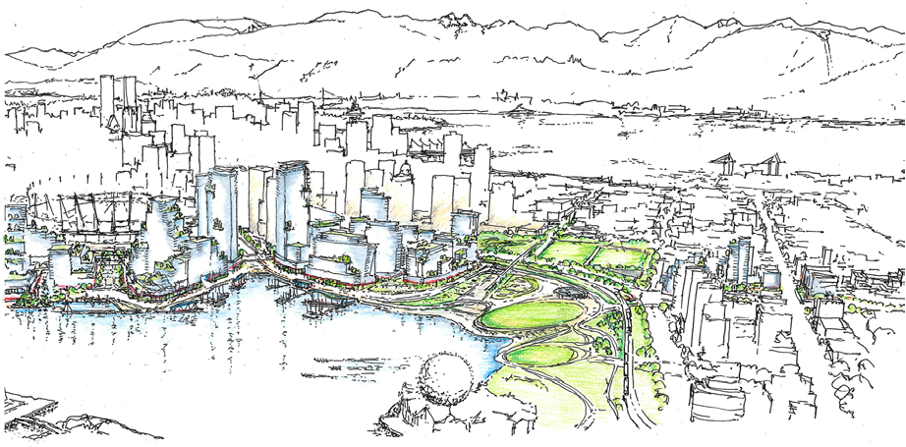NORTHEAST FALSE CREEK RENEWAL AND DEVELOPMENT PROJECT
IN VANCOUVER, BRITISH COLUMBIA, EARNS ENVISION® PLATINUM RATING
Consisting of an area of approximately 58 hectares, Northeast False Creek is the largest remaining underdeveloped waterfront area in the city of Vancouver. Northeast False Creek has a long and vibrant history; it was an important area for fishing, harvesting, and hunting by the Musqueam, Squamish and Tsleil-Waututh Nations, on whose unceded traditional homelands the city of Vancouver is situated. It was an active center in Vancouver’s industrial past, with rail yards, lumber mills, and shipbuilding activities dominating its shores in the early 20th century. Later, Northeast False Creek welcomed the world to Vancouver as the site of the Expo ’86 World’s Fair. Since then, the land has remained largely vacant, hosting temporary events and serving as an event-staging area for two nearby entertainment arenas.
The existing Georgia and Dunsmuir viaducts were completed in the early 1970s as part of a plan for a larger freeway system that was never constructed. The viaducts, one of the only elements of the freeway plan to be finished, continue to act as main thoroughfares to and from Vancouver’s downtown core.
In 2015, Vancouver City Council chose to move forward with planning initiatives to replace the Georgia and Dunsmuir viaducts with a reconfigured ground-level road network. Replacing these viaducts unlocks many opportunities and benefits, including:
– adding public spaces, facilities and amenities;
– replacing seismically vulnerable infrastructure with safe, reliable, and resilient infrastructure networks that enhance the City’s emergency preparedness and remain adaptable to meet future challenges; and
– improving the transportation and utility networks to support increased mixed-use commercial and residential development in Northeast False Creek.
The Vancouver City Council approved the Northeast False Creek Plan, of which the viaduct replacement project is a foundational part, in 2018. The Plan presents a self-funding model for achieving public benefits through development potential and provides Vancouver a significant opportunity to embrace the rich history and culture of the area. The plan makes the most of existing local assets and the area’s proximity to the water and establishes a new community that better connects Vancouver’s east and west sides.

KEY SUSTAINABILITY ACHIEVEMENTS
Restoration of historic and cultural resources. In the 1960s, residents of a historic Black neighbourhood known as Hogan’s Alley and parts of Chinatown were displaced for the construction of the Georgia and Dunsmuir viaducts. The development of the Northeast False Creek Plan included extensive stakeholder engagement to identify opportunities to acknowledge and redress the marginalization, discrimination, and displacement experienced by the Black and Chinese Canadian communities in the area and to strengthen relations with local First Nations and urban Indigenous communities. Some of the major outcomes of this collaboration include:
Recognizing the history of Hogan’s Alley, including through the establishment of a 27,000 square foot cultural centre to serve as a focal point for Vancouver’s Black Community, honour the history and contributions of Black Canadians to the area, and support community building through food, celebration, education and empowerment.
Reconnecting historic communities, including Chinatown, with the False Creek waterfront by removing the physical and visual separation from the water created by the existing viaduct structures.
Implementing a public art plan to explore the area’s history, ecology, communities, and landscape through opportunities for public art, including art relating to reconciliation and recognition of Musqueam, Squamish and Tsleil-Waututh Nations.
Investing in public space and amenities. Quality of life depends on the quality of public spaces: streets, parks, plazas and other social spaces. Streets provide the necessary connectivity between new and existing neighbourhoods and public amenities while also providing a network of public space where a diversity of public life can unfold. Public life thrives when public spaces are abundant and inviting. To this end, the streetscape design emphasizes “stickiness” – a design concept that invites people to stop and stay. This will be achieved by offering a variety of seating types; softening the road networks with landscaping; providing overall placemaking and a sense of character; adding dedicated spaces and integrated utilities to accommodate pop-up and semi-permanent kiosks, markets, vendors, and art installations; improving the tree canopy; and widening pedestrian pathways as well as adding protected bicycle paths.
Ensuring safe and inclusive streets for everyone. Safety, accessibility, and wayfinding were key elements of the project from the earliest conceptual stages. The completed project will offer safe, accessible, convenient, and resilient transportation options for people of all ages and abilities, emergency vehicles and goods movement. Wide sidewalks, protected bike lanes, signalized crossings, pedestrian-scale lighting, ample seating, and covered bus waiting areas will provide a safe and comfortable experience for people moving through the area. The innovative resilient roadway concept applied to the design of Pacific Boulevard will provide post-disaster serviceability between a new hospital campus and downtown, achieved by designing the roadway to withstand severe earthquakes.
Sustainability as a core value. Sustainability and resiliency were foundational lenses through which project decisions were made throughout planning and design. Careful alignment of the project goals with existing City policies regarding climate mitigation and action, including the Greenest City Action Plan and the Climate Emergency Action Plan, aided in ensuring the project team remained focused and united on achieving sustainable outcomes. This commitment was further underscored by the project’s sustainability charter, which was signed by key members of the project team. Some of the key focus areas for sustainable solutions include:
– Green transportation. Improving multi-modal transportation opportunities throughout the area and setting the standard for new development by providing greater access to electric vehicle charging and car share facilities, as well as transit, pedestrian, and cycling opportunities.
– Economic Opportunities. Servicing at least 1.8 million square feet of job space in the project area to support long-term economic growth objectives and diverse employment opportunities from low threshold/entry-level jobs to employment in the high tech and creative economies.
– Access to Nature. Connecting communities to the waterfront through removing the viaduct structural barriers, and including new public open spaces in the design.
– Climate Leadership. Implementing strategies to address risks and vulnerabilities identified in the City’s Climate Change Adaptation Strategy, such as implementing measures to address sea level rise, incorporating green infrastructure, and building a resilient roadway corridor.
SOUNDBITES:
“The City of Vancouver prides itself on its long-standing commitment to sustainability and climate action and that commitment manifests itself in all our projects, regardless of scale. The Envision Framework and third party verification process gave us the opportunity to highlight existing City policies that hold our projects to high standards of sustainability and pushed our team to think critically about how to go further, to innovate, and to leverage the opportunities afforded us by the Northeast False Creek Project’s scale to make bold moves towards our vision for a sustainable, resilient Vancouver.”
Megan Pate, Design Lead — Northeast False Creek Project, City of Vancouver
“Everyone who worked on the Northeast False Creek Project deserves recognition for their commitment to delivering a project that is sustainable, resilient, and equitable. Earning Envision® Platinum is no easy feat; it takes extraordinary effort to apply the key sustainability considerations needed. To do so, the project team must put resiliency, sustainability, equity — and the community’s needs —first. But, the city of Vancouver is dedicated to doing just that, including putting climate action and community progress front and center. Way to go team!”
Melissa Peneycad, ISI’s managing director



